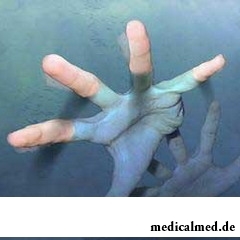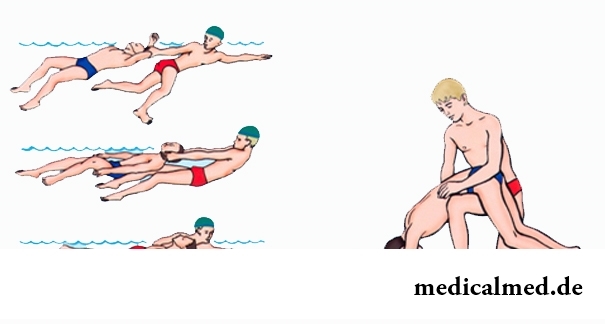





First aid when drowning
 The statistics of drownings is disturbing – by different estimates, every year in Russia sinks from 3 000 to 10 000 people, this population of a small town. The most frequent reason of mortality on water specialists call alcoholic intoxication, about 40% of all cases of drowning fall to its share. The reason, the second for frequency, – self-confidence how strange it sounded. People revaluate the opportunities and underestimate the risks connected with bathing in reservoirs and it leads sometimes to tragic effects.
The statistics of drownings is disturbing – by different estimates, every year in Russia sinks from 3 000 to 10 000 people, this population of a small town. The most frequent reason of mortality on water specialists call alcoholic intoxication, about 40% of all cases of drowning fall to its share. The reason, the second for frequency, – self-confidence how strange it sounded. People revaluate the opportunities and underestimate the risks connected with bathing in reservoirs and it leads sometimes to tragic effects.
Society of rescue on waters in order to avoid drowning urges to follow the following rules of conduct:
- Not to come into water in a state of intoxication;
- Not to dive in the unfamiliar place;
- Not to approach vessels by swimming, not to be on a vessel course even if this vessel represents the small boat, the motor boat or the water bicycle;
- Not to swim away far on air mattresses, circles, toys, etc.;
- Not to organize the dangerous games in water connected with comic drowning, captures, a fright, tightening under water;
- Children have to be near water and the more so in water only accompanied by adults and under their vigilant control.
Observance of these simple rules could prevent the lion share of the tragedies connected with death of the person on water. Unfortunately, the understanding of importance of it sometimes comes too late.
What to do if accident happened? It is necessary to start first-aid treatment because in this case human life directly depends on that how bystry and true were actions of the rescuer immediately.
As it is correct to pull out the victim on the coast
Task of the rescuer not only to save drowning, but also to keep the life and as it is necessary to do everything quickly and there is no time for reflections, it is necessary to know accurately following:
- It is necessary to approach the victim behind, to take so that he could not seize the rescuer (it occurs reflex, sinking the actions it is not capable to control). At rescuers taking of the victim behind for hair is considered classical if their length allows. As if roughly it sounded, nevertheless, such option is effective as it allows to move, hold rather conveniently and quickly the victim's head over water and to secure itself against the fact that having seized a death grip it will drag away the rescuer on depth;
- If nevertheless drowning seized the rescuer and pulls it down, it is necessary not to beat off, and to dive – in this case drowning will instinctively unclench hands.

Types of drownings
When the victim is pulled out on the coast, it is necessary to estimate quickly what type of drowning it was necessary to face as the algorithm of first aid will depend on it.
Distinguish two main types of drowning:
- Blue, or wet (sometimes it is called still true drowning) – when inside, a large amount of water came to a stomach and airways. Skin of the victim becomes blue because that water, having quickly got to a blood stream, dilutes with itself blood which in this state easily filters through walls of vessels, giving to skin a cyanotic shade. One more sign of wet, or blue drowning – from a mouth and a nose of the victim is allocated a large amount of pink foam, and breath gains the bubbling character;
- Pale, or dry (called by also asphyxial drowning) – when in the course of drowning the victim has a laryngospasm, and water does not get into respiratory tracts. In this case all pathological processes are connected with shock and the coming suffocation. Pale drowning has more favorable forecast.
Algorithm of first-aid treatment
After the victim is pulled out on the coast, upper respiratory tracts should be exempted quickly from foreign objects (ooze, dentures, emetic masses).
As when drowning wet, or blue type, in respiratory tracts of the victim there is a lot of liquid, the rescuer has to lay it on the knee a stomach, facedown, to allow to flow down to water, to thrust to the victim two fingers into a mouth and to press on a language root. It becomes not only to cause vomiting which will help to exempt airways and a stomach from the water which was not in time to be soaked up, but also to help to start respiratory process.
If everything turned out, and the rescuer achieved emergence of emetic masses (their distinguishing character presence of undigested pieces of food is), it means that first aid appeared in time in time, is carried out correctly, and the person will live. Nevertheless, it is necessary to continue to help it to delete water from airways and a stomach, without stopping pressing on a root of language and causing again and again emetic reflex – until in the course of vomiting water does not cease to be emitted. At this stage cough develops.
If several attempts in a row to cause vomiting were unsuccessful if confused breath or cough did not appear at least, it means that there is no free liquid in airways and a stomach, it was soaked up. In this case it is necessary to turn immediately the victim on a back and to start resuscitation.
First-aid treatment when drowning dry type differs in the fact that in this case it is necessary to start resuscitation at once after release of upper respiratory tracts, passing a stage of calling of vomiting. In this case there are 5-6 minutes to try to start respiratory process at the victim.
So, in summary form an algorithm of first-aid treatment when drowning following:
- To exempt upper respiratory tracts (a mouth and a nose) from foreign substances;
- To throw the victim through a knee, to allow to flow down to water, to cause vomiting and as much as possible fully to remove water from a stomach and airways;
- If there was an apnoea, to start resuscitation (an artificial cardiac massage and breath of companies - in - a mouth or a mouth - in - a nose).
When drowning pale, or dry type the second stage is passed.
Actions after first-aid treatment
After it was succeeded to start independent breath, the victim is stacked on one side, covered with a towel or a plaid to warm. It is necessary to call the ambulance surely. Before arrival of the doctor the victim has to reside under control, in case of an apnoea resuscitation actions should be resumed.
The rescuer shall insist on medical assistance to the victim even if that is capable to move independently and refuses it. The matter is that terrible effects of drowning, such as hypostasis of a brain or lungs, a sudden apnoea, etc., can come also in several hours, and even in several days after accident. Danger is considered passing only when 5 days later after incident no serious problems with health arose.
Many drugs initially moved ahead in the market as drugs. Heroin, for example, was initially brought to the market as children's cough medicine. And cocaine was recommended by doctors as anesthesia and as the means increasing endurance.

Such trouble as the milkwoman's attack, at least once in life happened almost to each woman. Prevalence забол...
Section: Articles about health
You are office worker, the driver, the fan of winter sports or do not think of life without bicycle? You lead a slow-moving life and you move on the city only on the car? You have no constant partner and you do not love the protected sex? Attention! You one...
Section: Articles about health
It is difficult to revaluate importance of kidneys for an organism. These bodies not only perform work on purification of blood of decomposition products and removal of excess liquid. They are responsible also for production of some hormones necessary for maintenance of a normality of a bone tissue, and also for a producing red blood cells – erythrocytes....
Section: Articles about health
The sclera and mucous membrane of an eye are intensively supplied with blood vessels which problem - to sate nervous tissues of body to a pitata...
Section: Articles about health
Urogenital candidiasis (milkwoman) – a fungal infection which annoys unpleasant feelings in the field of generative organs, being followed by white curdled allocations, an itch, discomfort during an urination, pain. She is called by Candida fungus – a mustache...
Section: Articles about health
The immunity role in growth of the child is invaluable. The proteins-immunoglobulins produced by immune system preserve the child against the diseases capable − owing to an organism weak still − to serve as a stressful factor, to become the reason of many complications and delays in development of the kid. If the immune system weakened, health of the child is under direct threat and needs active actions for strengthening of protective forces of an organism − preferably non-drug....
Section: Articles about health
Cold, puffiness of a nose, itch, the watering eyes - characteristic symptoms of the allergic rhinitis resulting from hit and...
Section: Articles about health
Residents of big cities quite often have a disease which is known as the syndrome of chronic fatigue (SCF) today. This illness affects the people belonging to various social and demographic groups and living on all continents. Most of all SHU to a podverzha...
Section: Articles about health
Statistically, pathologies of a thyroid gland in the world more than 500 million people have. Failures in work of this body lead to heavy disbolism, development of heart diseases, vessels, a reproductive and nervous system. In hard cases excess or insufficient production of the main hormones of a thyroid gland (thyroxine and triiodothyronine) leads to essential decline in quality of life and disability....
Section: Articles about health
Tuberculosis – a serious infectious disease which development is caused by mycobacteria (Koch's bacilli). The illness is known from a deep d...
Section: Articles about health
The stroke is one of the most widespread diseases of the person, annually in the world about 6 million cases of this pathology are registered. According to medical statistics, strokes occur almost three times more often than myocardial infarctions. Disease otno...
Section: Articles about health
Season of activity of viral infections in the heat. Everyone can get sick, but probability of this unpleasant event it is possible and it is necessary to minimize. There is a number of rules, following to which will help or to avoid absolutely infection with flu or a SARS, or to have an illness benign and without essential complications. About ways of prevention of seasonal infections the speech in this article will also go....
Section: Articles about health
The chia plant, or the Spanish sage, is from South America. The indigenous people of the continent since ancient times used in food it семена:...
Section: Articles about health
Eyes – one of the most vulnerable areas on a face therefore age changes concern them first of all. Whether it is possible to keep look youth for many years and what procedures are offered for achievement of this purpose by cosmetologists? And maybe, only thing of a vari...
Section: Articles about health
Feeding by a breast - the integral part of ideal motherhood allowing to come into contact with the kid and to create to it healthy immunity since early years. Nevertheless, this important process in life of mother and child can be saddened laktostazy − by a milk delay in a mammary gland. What main reasons for a laktostaz? How not to allow problems with breastfeeding? Let's consider 10 premises resulting in stagnation of milk at the nursing mother....
Section: Articles about health
Healthy lifestyle today in fashion, and many parents think of that the child from the early childhood played sports. To a Torah...
Section: Articles about health
High temperature - a frequent symptom of such widespread diseases as a SARS, quinsy, pneumonia, etc. To reduce heat, having facilitated a condition of the patient, doctors recommend to accept antipyretics, however their use is not always possible. Too h...
Section: Articles about health
Dietary supplements (dietary supplements) for the last decades were so thoroughly included into our life that, apparently, it is already impossible to find the person who at least once did not try them. At the same time, most of our compatriots have a vague idea of what dietary supplements as they affect a human body consist of and what differ from the real medicines in. Let's try to understand these questions, and at the same time and to understand, such additives are how necessary for us....
Section: Articles about health
The medicine promptly develops, and the fact that else quite recently it seemed by miracle can now. We are not surprised any more to the fact that sport...
Section: Articles about health
All are familiar with cold, and practically everyone believes that he has sufficient knowledge and experience that correctly to treat it. In practice most of people makes mistakes in attempts to get rid of rhinitis, and divides numerous delusions it....
Section: Articles about health
The fatigue, sleep debt, disturbances of food, bad mood, vagaries of the weather – all these circumstances badly affect our appearance. Especially the person suffers: skin becomes flabby, loses healthy color, becomes covered by wrinkles, zones of hypostases and dark circles under eyes appear. It is not always possible to be saved from influence of aggressive factors, but we are quite able to minimize its effects. For this purpose usually apply the cosmetics and procedures helping увлаж...
Section: Articles about health
On the head of the person about one million hair follicles, or as they are called still, hair bulbs are located. At the moment he is born...
Section: Articles about health
It is known that the person for 80% consists of water which participates in all processes of an organism. The person loses liquid daily – as a result of sweating, breath, an urination, and its insufficient completion due to various reasons can bring to обезвожив...
Section: Articles about health
The number of long-livers is very small. One person from 5 thousand lives up to age of 90 years, and the centenary boundary steps over only one of 20 thousand. However, doctors claim that each of us is quite able to affect own destiny. At the same time it is not so much about living as long as possible, how many about an opportunity to keep physical and intellectual activity and to avoid decrepitude. We will also talk about the ways helping to achieve this result today....
Section: Articles about health
Transfusion of donor blood has almost century history. In spite of the fact that this procedure is quite usual for many people, itself п...
Section: Articles about health
80% of women at least once to lives complained of discomfortable feelings to breasts, consolidations and nagrubaniye. These are mastopathy symptoms. The mastopathy is characterized by change of a ratio between ferruterous and connective tissue tissues of mammary glands. It can bring...
Section: Articles about health
Wood louse – the ordinary-looking unpretentious plant extended in all territory of our country. It quickly expands, and sometimes fills sites, bringing a lot of chagrin to gardeners. Perhaps, they would be upset less if knew that the wood louse is valuable medicinal raw materials. A, C and E vitamins, organic acids, tannins, wax, saponins, lipids, mineral salts and essential oils are its part....
Section: Articles about health
